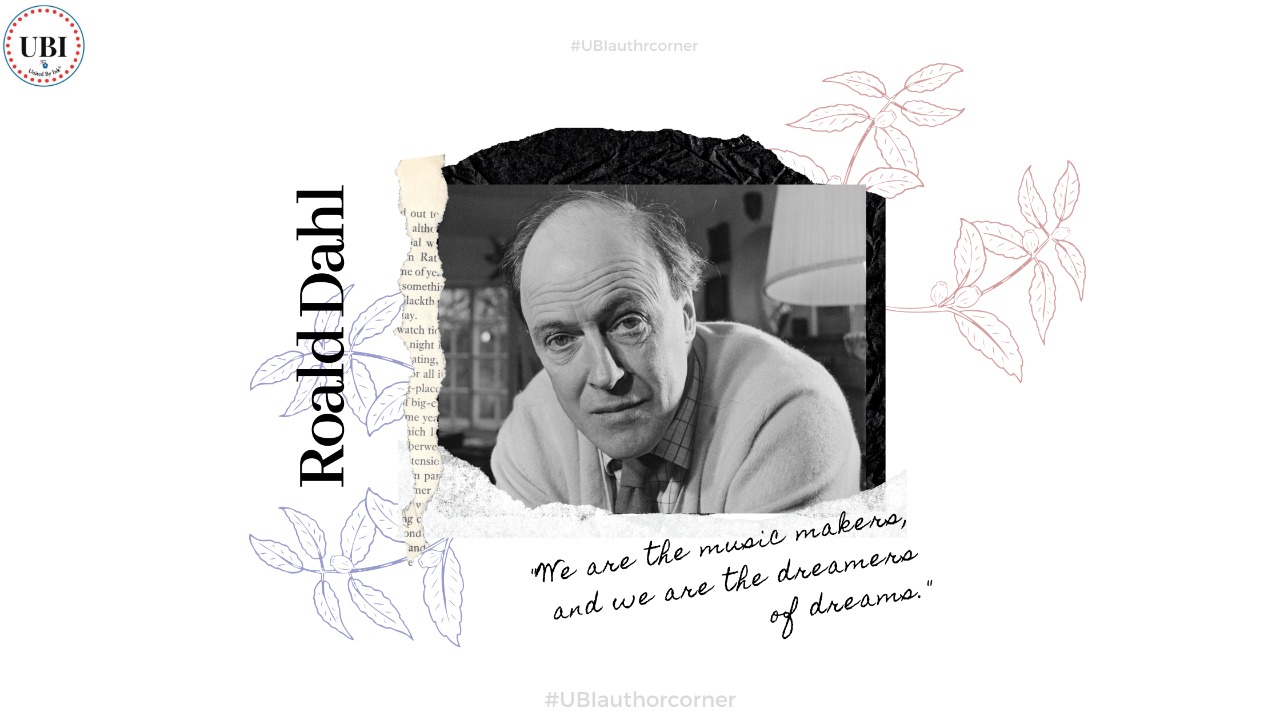
Full name – Roald Amundsen
Death – 1960, age 74
Nationality – English
“A person is a fool to become a writer. His only compensation is absolute freedom. He has no master except his own soul, and that, I am sure, is why he does it”
– Roald Dahl
Roald Dahl was a British novelist, short-story writer, poet, screenwriter, and wartime fighter pilot who penned 19 children’s books over his decades-long writing career. His books have sold more than 250 million copies worldwide. Dahl’s short stories are known for their unexpected endings, and his children’s books for their unsentimental, macabre, often darkly comic mood, featuring villainous adult enemies of the child characters.
Family, education and early life –
Born in Llandaff, Wales, on 13th September 1916 to Norwegian parents, Harald Dahl and Sofie Magdalene Hesselberg, Dahl was named after Roald Amundsen, the Norwegian who had been the first man to reach the South Pole just four years earlier. A heroic start in life. But his early years were blighted by the tragic deaths of his older sister, Astri, and his father. He was sent to boarding school – first to St Peter’s, Weston-super-Mare; then, in 1929, to Repton – where many bizarre and memorable events would later be recounted in ‘Boy’. Pupils at Repton were invited to trial chocolate bars, a memory that stayed with Dahl throughout his life, inspiring yet another masterpiece which we know as ‘Charlie and the chocolate factory’.
While Dahl hardly excelled as a student, his mother offered to pay for his tuition at Oxford or Cambridge University when he graduated. Dahl’s response, as quoted from his autobiography, Boy: Tales of Childhood, was, “No thank you. I want to go straight from school to work for a company that will send me to wonderful faraway places like Africa or China.” Schooldays happily behind him, Dahl’s lust for travel took him first to Canada, then to East Africa, where he worked for an oil company until the outbreak of World War Two. He enlisted in the Royal Air Force at 23 years old. After training in Nairobi, Kenya, he became a World War II fighter pilot. While serving in the Mediterranean, Dahl crash-landed in Alexandria, Egypt. The plane crash left him with serious injuries to his skull, spine and hip. Following a recovery that included a hip replacement and two spinal surgeries, Dahl was transferred to Washington, D.C., where he became an assistant air attaché.
In September 1940, Dahl received severe injuries to his head, nose and back when his Gladiator crash-landed in the Western Desert. After six months recovering from his injuries in Alexandria he returned to action, taking part in The Battle of Athens. Later, after a posting to Washington, he supplied intelligence to MI6.
In 1953 Roald Dahl married the American actress, Patricia Neal, with whom he had five children. They divorced after 30 years, and he later married Felicity “Liccy” Crosland, who furthered Roald’s legacy through foundations in his name and beliefs.
Later life and literary fame –
Roald Dahl began his writing career with short stories; in all, he published nine short story collections. Dahl first caught the writing bug while in Washington, D.C., when he met with author C.S. Forrester, who encouraged him to start writing. Dahl published his first short story in the Saturday Evening Post. He went on to write stories and articles for other magazines, including The New Yorker.
Dahl first established himself as a children’s writer in 1961, when he published the book James and the Giant Peach which met with wide critical and commercial acclaim. Three years after his first children’s book, Dahl published another big winner, Charlie and the Chocolate Factory.
Of his early writing career, Dahl told New York Times book reviewer Willa Petschek, “As I went on the stories became less and less realistic and more fantastic.” He went on to describe his foray into writing as a “pure fluke,” saying, “Without being asked to, I doubt if I’d ever have thought to do it.” Dahl wrote his first story for children, The Gremlins, in 1942, for Walt Disney. The story wasn’t terribly successful, so Dahl went back to writing macabre and mysterious stories geared toward adult readers. He continued in this vein into the 1950s, producing the best-selling story collection Someone Like You in 1953, and Kiss, Kiss in 1959.
Roald also enjoyed enormous success on television. Having already had his stories told in six episodes of the award-winning US series Alfred Hitchcock Presents, his Tales of the Unexpected ran for several series between 1979 and 1988 in the UK.
In the early 1980s he published The Twits, The BFG, Revolting Rhymes and The Witches. There followed two autobiographical books: Boy, in 1984 and Going Solo, in 1986. Matilda was published in 1988, Esio Tort in 1990, and finally, in 1991, came the posthumous delight of The Minpins.
Roald Dahl died on 23 November 1990, aged 74. He was buried in the parish church of St Peter and St Paul in Great Missenden – the Buckinghamshire village where today The Roald Dahl Museum and story centre continues his extraordinary mission to amaze, thrill and inspire generations of children and their parents.
How useful was this post?
Click on a star to rate it!
Average rating 1 / 5. Vote count: 2
No votes so far! Be the first to rate this post.

UBI stands for United By Ink®️. UBI is a Global Platform- the real-time social media interactive forum created for Readers, Writers and Facilitators alike.This platform aims to help creative souls realize their writing goals.
Click on our representatives below to chat on WhatsApp or send us an email to ubi.unitedbyink@gmail.com
